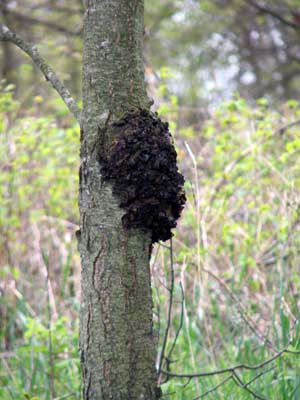
What is Black Knot Fungus?
Black Knot Fungus, caused by the pathogen Apiosporina morbosa (formerly known as Dibotryon morbosum), is a common and often serious fungal disease that primarily affects species of Prunus, particularly plums and cherries, both ornamental and fruit-bearing. If you suspect your tree has Black Knot, an Atlanta Arborist like Caldwell Tree Care may be able to help.
Identifying Black Knot Fungus
Identifying Black Knot Fungus involves observing specific symptoms that manifest primarily on the branches, with less distinct signs on leaves and trunks. Here’s how to identify it based on these parts of the tree:
Branch Symptoms
- Characteristic Knots: The most obvious sign is the appearance of dark, swollen, knotty growths on the branches. These knots start as small, olive-green swellings and eventually turn black and hard.
- Growth Pattern: The knots can encircle the entire circumference of a branch and may vary in size from a small lump to an elongated, gnarled mass.
- Branch Distortion: Infected branches often exhibit abnormal growth or distortion due to the presence of the knots.
- Brittleness: As the disease progresses, the affected branches may become brittle and break easily.

Leaf Symptoms
While Black Knot Fungus primarily affects branches, there can be indirect effects on the leaves:
- Reduced Vigor: Infected branches may show reduced leaf growth, and leaves might be smaller than usual.
- Wilting: Leaves on severely infected branches may wilt due to the impaired nutrient and water flow.
- Yellowing: In some cases, leaves may yellow and drop prematurely, although this is a less specific symptom and could indicate various issues.
Trunk Symptoms
Black Knot is less commonly found on tree trunks, but when it does occur:
- Knot Formation: Similar knotty growths as seen on branches can develop on the trunk, though this is rarer.
- Overall Health Decline: Extensive infection can lead to a general decline in tree health, which may manifest in the trunk as decreased growth, dieback, or increased susceptibility to other diseases and pests.
How To Control Black Knot Fungus
Pruning and Sanitation
The primary method for controlling Black Knot is through good sanitation measures, including pruning out all galls from infected trees, preferably during the tree’s dormant period. It’s important to prune infected branches six to eight inches below each gall and, in the case of trunks, to remove tissue from at least one inch beyond the infected area. Proper disposal of the infected material by burning or burying is crucial to prevent the spread of the fungus.
Proper Disposal of Infected Material
After pruning, disposing of the infected material properly is essential. Burning or burying the pruned material helps prevent the spread of the fungus.
Timing of Pruning
Winter pruning, ideally in late winter (February or March), when temperatures are below freezing, is crucial. This timing helps prevent spore infection. Careful inspection and removal of infected branches during this period are important, along with proper disposal of infected materials.
Fungicide Application
Using fungicides strategically is vital in treating and preventing Black Knot disease. Copper-based fungicides are recommended to inhibit fungal growth and spore production. The timing of the application is critical for maximum effectiveness and is often recommended between the white bud and petal fall stages of tree development.
Removal of Wild Hosts
Removing wild plum, prune, and cherry seedlings from fence rows, woodlots, and orchard perimeters is advised, as they can serve as a source of the disease.
Maintaining overall tree health and monitoring for early signs of infection are also crucial in managing Black Knot. Consulting with local extension services or professional arborists can provide more specific advice tailored to the particular conditions of the affected area.
